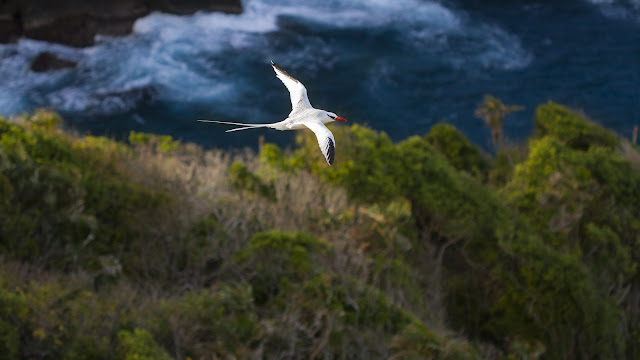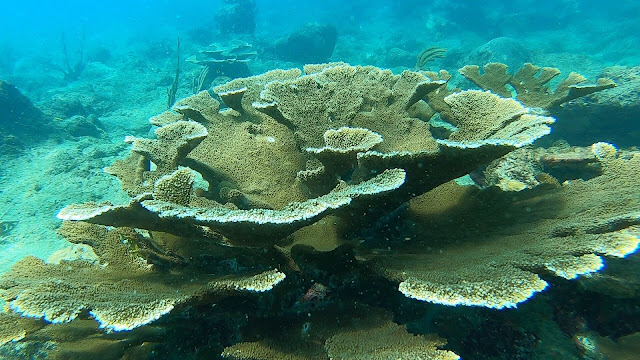Saving our Seas
Dr Anjani Ganase considers recent scientific studies on sea urchins, coral reefs and management targets; and arrives at the conclusion expressed by environmentalist David Attenborough and echoed by other scientists and ocean advocates. The Ocean must be protected and managed everywhere.

Long spined sea urchin.
Photo by Jonathan Gomez
Sea Urchins: pest or protector
The Caribbean Sea is lined by islands and coral reefs that are unique. Forty years ago, these coral reefs were dominated by sea urchins, specifically the long-spined sea urchin (Diadema antillarum). These urchins were once regarded as a nuisance especially in the shallows in the seagrass beds. However, only after the 1980s, did we recognise the critical function of this specific species of sea urchin after they were destroyed by a disease throughout the Caribbean. These were important grazers, like cows grazing a meadow, ensuring that the bare surfaces of reefs were regularly cleaned of algae, thereby allowing coral recruits to settle and grow. Before the 1980s, they were many urchins on the reefs, then by mid-eighties a disease originating in Panama spread throughout the Caribbean decimating the population. Forty years later these urchins continue to be rare on reefs, and combined with the impact of nutrient pollution and overfishing of parrotfish and other major grazers on the reefs, many reefs are smothered in turf and macroalgae across the Caribbean. Conservation scientists are seeking to increase sea urchin numbers on coral reefs through breeding programmes.
In contrast to the Caribbean, we have the reef systems of Hawaii. The remote setting of Hawaii in the middle of the Pacific, also give uniqueness to their coral reefs and also a relatively similar diversity of hard coral species and of endemic species to that of the Caribbean. The unique community of corals also means a unique community of fish and invertebrates. In recent years, scientists surveying specific sites around Hawai'i Island found that site of overfishing and pollution have driven up the numbers of sea urchins on reefs. Contrary to Caribbean reefs, in Hawaii the high number of sea urchins, while they do graze on algae, it also results in severe erosion of the coral framework if densities get too high. The impact may be related to the great branching corals that are more fragile and prone to breakage from grazing. Studies like these highlight the need to understand that conservation strategies that work in one place may not apply in another. Often a deeper understanding of the reefs at the local level is essential for effective management.

Golden kelp, South
Australia are at risk of loss from global warming. Credit: Stefan Andrews /
Ocean Image Bank
Coral adaptations affecting other ecosystems
Scientists from the Hawaiian Institute of Marine Biology Marine Ecological Theory Lab highlighted that current climate change is likely occurring too rapidly to facilitate substantial poleward shift of coral communities away from the tropical regions to cooler waters. They were able to show this by modelling historical climatic change, such as the changes during the Late Pleistocene which resulted in poleward shifts of coral reefs to higher latitudes. This was compared with the current trajectory and the future scenarios of carbon emissions. Using factors such as temperature, pH and light radiation to identify areas suitable for coral establishment and about 50,000 representative reef systems, this super model required supercomputing. Both current and historical models of distribution were proofed by existing records of coral formation.
It is to be noted that historical climate changes occurred over long periods of centuries, slow enough for the rate of decline in the tropics to be matched with the pace of coral adaptation and migration to higher latitudes. This can possibly result in a subset of coral species surviving rapidly shifting climates, but how many species and over which area are less certain. The current rates of climate change occur on the scales of decades (some 40 – 80 years) means that the rate of decline is so rapid that it does not allow natural shifts in coral distribution to higher latitudes as tropical conditions become inhospitable. There is some hope as models indicate that efforts to curb carbon emissions can slow the rate of degradation enough to facilitate natural expansion. This means that some coral shifts might occur in the near future, possibly the next hundred to a thousand years. Regardless, all scenarios come with biodiversity loss of native high latitude ecosystems. It is also likely that some species typically dominant in kelp forest and seagrass ecosystems would be impacted by heat stress and squeezed out by corals and other tropical organisms.

School of Hammerhead
sharks, Mikimoto, Japan. Credit: Masayuki Agawa / Ocean Image Bank
Protection for all oceans needed
A project called MegMove, led by Australian National University, compiled by satellite, mapped the migratory tracks of over 12,000 marine animals across 100 species around the world. The study aimed to reveal how much the marine animal migratory routes, feeding grounds, breeding grounds and other hotspots of megafauna interact with human activities. In fact, the project showed that most of megafauna activities fall outside of existing marine protected areas. Consider the current effort of the United Nations' 30x30 target: a global goal to protect 30 percent of the world's oceans by 2030. Even under the most ideal scenario where 30% of the best areas of the ocean are protected and effectively managed, this will still not be enough for effective protection of 60 % of migratory organisms surveyed. These organisms include sea birds, marine mammals such as dolphins, whales, even manatees, fish such as tunas and several species of shark, penguins, polar bears and marine turtles. The study emphasises the urgent need for other controls of management to complement marine protection, such as fisheries management, rerouting of shipping lanes, and targeted efforts to track and reduce pollution at sea.
The bold vision proposed by ocean advocate and marine policy researcher Deborah Rowan Wright in her book Future Sea, would be to protect and manage all the ocean (100%), ending destructive industrial activities in order to enable wildlife to return to seas around the globe.
Reference
Noam S. Vogt-Vincent et al. , Anthropogenic climate change will likely outpace coral range expansion.Sci. Adv.11,eadr2545(2025).DOI:10.1126/sciadv.adr2545
van Woesik KJ, Li J, Asner GP (2025) Scaling-up coral reef carbonate production: Sea-urchin bioerosion suppresses reef growth in Hawaiʻi. PLOS ONE 20(5): e0324197. https://doi.org/10.1371/journal.pone.0324197
Virginia Tech. "Satellite tracking of 12,000 marine animals reveals ocean giants are in trouble." ScienceDaily. ScienceDaily, 7 June 2025


